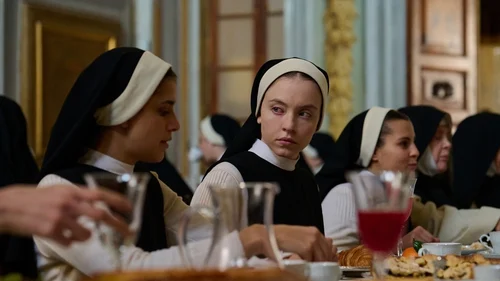It will shock many of my readers, but the nunsploitation genre is a bit of a cinematic blindspot for me. I know; it’s weird to me, too.
Even with my limited knowledge, though, Michael Mohan’s Immaculate is a tame affair by the genre’s and Sydney Sweeney’s standards. You’ll find no lesbian nuns, rampant drug use, or Satanic cabals in Andrew Lobel’s script. However, the film’s mercifully brief runtime makes the nuts-and-bolts horror film all the more enjoyable. Immaculate may not be great, but swaths of it are a blast, enough that I’d hardly call it bad.

Still, one day, Sweeney will work with a director who’s more than a journeyman, and on that day, the world will know how badly we’ve misused her. Like Alexandra Daddario, another talented actor more famous for her body than her talent, Sweeny displays an old-school Hollywood charm with a furious physicality when called upon. To Mohan’s credit, he utilizes Sweeney’s fearlessness and gets out of her way once things at the Italian convent start to unravel.
But Mohan and Elisha Christian’s camera fails to create a vibe or mood throughout Immaculate. What little sinister air does exist is crafted through Sweeney’s Sister Cecilia rather than Christan’s camera. Christian delivers some nice flourishes, such as the scene with the confession booth, in which the Monsignor seems to be farther and farther away as Cecilia confesses. Ultimately, the visual palate of Immaculate is as pedestrian as Mohan’s directing.
Even Lobel’s script largely falters, failing to make the mysterious and eerie happenings at St. Benedict compelling. The answer to the how and whys of Ceceila’s strange and not-so-miraculous pregnancy is bonkers. But in Lobel and Mohan’s hands, it comes off like the resolution of an Old Dark House movie, where the reveal is never as intriguing as what the film had hinted at.
Worse is how Mohan fails to utilize the rest of the cast of Immaculate. Characters like Sister Gwen (Bernedetta Porcaroli), the chain-smoking sister-in-arms who befriends Cecelia. She is the only one who seems to care for her well-being before or after the “miracle.” Despite making an impression, her character spends much of the movie absent.
There is a style of film I call sketchbook cinema. This is the kind of movie where the script could fit on a napkin, but the craftsmanship of the filmmaking overcomes this by creating a world and tone so overwhelming that it doesn’t matter. Immaculate would be a perfect contender if Immaculate were a more stylistically adventurous movie.
Mohan is trying to create an atmosphere of isolation, firmly planting Immaculate from Ceclia’s point of view. But he does it in a way that feels like the movie doesn’t want to waste time with anyone else. I’m torn. I admire the skinflint narrative and the meat-and-potatoes kind of horror that merely does what it set out to do and nothing more. But Sweeney is so good that I wish Immaculate were a little better.
The convent is a hospice for sick and elderly nuns. Cecilia and the other nuns aspire to make their last moments peaceful and joyful. Mohan hints that something far more devilish is behind the serene convent’s facade. Thankfully, he and Lobel sidestep the cliche of using mental illnesses as a jump scare and instead have it be the background radiation of Immaculate. The sickness and death are all around Cecelia as she is a life vessel.
However, stylistically, Mohan is largely impotent. Yet, he and Christian succeed in putting us in Celcia’s headspace. She’s an American who speaks little Italian and is often a few steps behind in every conversation because of it. Mohan and Christian do a good job of letting Sweeney’s expressive face do the work.

Immaculate is a passion project for Sweeney, and at first blush, it’s hard to see why. It’s a relatively simple story that lacks its genre brethren’s prurient and taboo aspects. Yet, as Immaculate races along, it becomes glaringly apparent why Sweeny was drawn to it: its strident anti-forced birth narrative blended with a light commentary on objectification.
Underneath all the drab exteriors and bad lighting beats a roaring feminist narrative that Sweeney highlights with her anxious eyes. At one point, during a check-up with the convent’s OB-GYN, the baby is declared fine, and Cecilia cries out, “But I’m not.” Sweeney’s Cecilia is defiant, skeptical, and terrified as she realizes how isolated she has become.
Her pleas to be taken to the hospital are ignored by the handsome Father, Sal Tedeschi (Alvaro Morte), and the ambivalent Mother Superior (Dora Romano). This is compounded by how the patients at the hospital seem obsessed with her beauty. Early at the airport, Cecilia is detained by customs, and upon learning that she is to take her vows that night, one of the officers looks her over and mutters, “What a waste.”
These twin themes are the most fascinating things about Immaculate if for no other reason than that the film stars one of the hottest “It” girls of the moment. Sweeney’s fame is divided into two halves: her sex appeal and talent. Often, the two are discussed separately, and the twain shall never meet. To say nothing about how she seems to be the crux of a bizarre online culture war focused less on her as a person or even as a personality and instead focused on her somewhat larger-than-average breasts.
Sweeney has also expressed a desire for motherhood, but on her terms and in a country that has struck down Roe V. Wade, the real horror of Immaculate stems from the very real fear of dehumanization that stems from stripping a woman of her choice. The reduction of a woman to nothing but a broodmare, where the offspring is more important than the mother. The two ideas intertwine and, in Sweeney’s deft hands, are given a bold and jaw-dropping exploration of how her eyes shine with terror at her powerlessness.
She throws herself into her performance, displaying a willingness to go feral in a way that had me clapping in the theater. Much has been written about her stilted line deliveries, but there’s a moment when her water breaks, and she utters a blasphemy that had me cackling. Immaculate may play it safe most of the time, but Mohan and Sweeny live and die by the Robert McKee adage, “Wow them in the end, and you got a hit.” Mohan may have his faults, but he allows Sweeny room to do her thing and knows how to cultivate an environment for her to thrive. That alone may explain why she’s worked with him twice.

Because once the third reel starts and the wheels start to come off, Immaculate is a howler of a movie. Sweeney takes a calibrated performance and ratchets it to a level where I hope she becomes a modern scream Queen. How Mohan capitalizes on the escalating tenor shows he might have a future as a journeyman director. Still, if for nothing else, the scene where Mohan and Christan frame Sweeney’s face as she caterwauls through giving birth is among the movie’s best scenes.
To say nothing of how effective the moments of gore are. Despite my issues, Immaculate is a fun, gross-out horror film. The jump scares are sporadic and fun, and the body-horror gore had me twisted up like a pretzel in my seat. One scene has Sweeney slowly peeling off a fingernail, which made me wincing and turning away.
But for the most part, Mohan and Lobel choose to let the possibility fester in our imaginations. Morte’s Father Sal has a monologue about the skin cells on the convent’s crucifix nail that is icky, gross, and deranged all by itself. Immaculate is a movie filled with small moments like these that culminate into the third reel smasher of an ending.
Immaculate proves yet again that Sydney Sweeney is a movie star. If she weren’t, Immaculate wouldn’t be half as entertaining as it is.
Images courtesy of Neon
Have strong thoughts about this piece you need to share? Or maybe there’s something else on your mind you’re wanting to talk about with fellow Fandomentals? Head on over to our Community server to join in the conversation!

